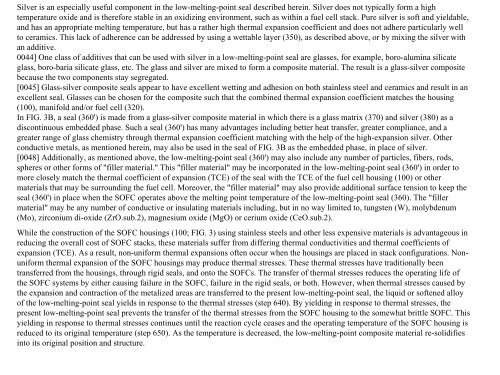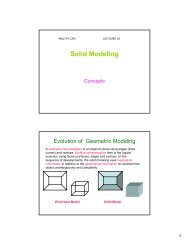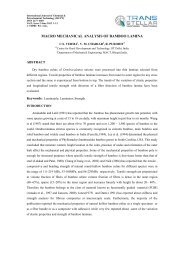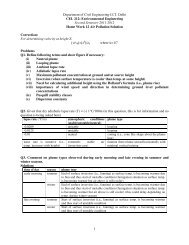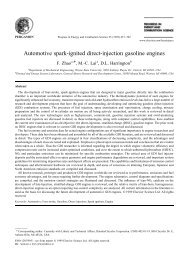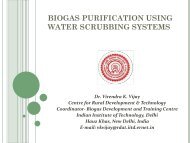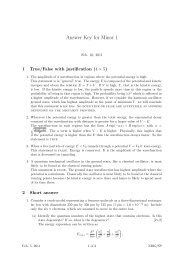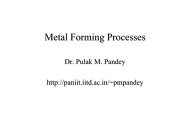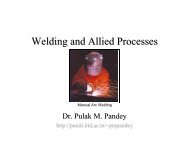Presentation - Indian Institute of Technology Delhi
Presentation - Indian Institute of Technology Delhi
Presentation - Indian Institute of Technology Delhi
You also want an ePaper? Increase the reach of your titles
YUMPU automatically turns print PDFs into web optimized ePapers that Google loves.
Silver is an especially useful component in the low-melting-point seal described herein. Silver does not typically form a high<br />
temperature oxide and is therefore stable in an oxidizing environment, such as within a fuel cell stack. Pure silver is s<strong>of</strong>t and yieldable,<br />
and has an appropriate melting temperature, but has a rather high thermal expansion coefficient and does not adhere particularly well<br />
to ceramics. This lack <strong>of</strong> adherence can be addressed by using a wettable layer (350), as described above, or by mixing the silver with<br />
an additive.<br />
0044] One class <strong>of</strong> additives that can be used with silver in a low-melting-point seal are glasses, for example, boro-alumina silicate<br />
glass, boro-baria silicate glass, etc. The glass and silver are mixed to form a composite material. The result is a glass-silver composite<br />
because the two components stay segregated.<br />
[0045] Glass-silver composite seals appear to have excellent wetting and adhesion on both stainless steel and ceramics and result in an<br />
excellent seal. Glasses can be chosen for the composite such that the combined thermal expansion coefficient matches the housing<br />
(100), manifold and/or fuel cell (320).<br />
In FIG. 3B, a seal (360') is made from a glass-silver composite material in which there is a glass matrix (370) and silver (380) as a<br />
discontinuous embedded phase. Such a seal (360') has many advantages including better heat transfer, greater compliance, and a<br />
greater range <strong>of</strong> glass chemistry through thermal expansion coefficient matching with the help <strong>of</strong> the high-expansion silver. Other<br />
conductive metals, as mentioned herein, may also be used in the seal <strong>of</strong> FIG. 3B as the embedded phase, in place <strong>of</strong> silver.<br />
[0048] Additionally, as mentioned above, the low-melting-point seal (360') may also include any number <strong>of</strong> particles, fibers, rods,<br />
spheres or other forms <strong>of</strong> "filler material." This "filler material" may be incorporated in the low-melting-point seal (360') in order to<br />
more closely match the thermal coefficient <strong>of</strong> expansion (TCE) <strong>of</strong> the seal with the TCE <strong>of</strong> the fuel cell housing (100) or other<br />
materials that may be surrounding the fuel cell. Moreover, the "filler material" may also provide additional surface tension to keep the<br />
seal (360') in place when the SOFC operates above the melting point temperature <strong>of</strong> the low-melting-point seal (360). The "filler<br />
material" may be any number <strong>of</strong> conductive or insulating materials including, but in no way limited to, tungsten (W), molybdenum<br />
(Mo), zirconium di-oxide (ZrO.sub.2), magnesium oxide (MgO) or cerium oxide (CeO.sub.2).<br />
While the construction <strong>of</strong> the SOFC housings (100; FIG. 3) using stainless steels and other less expensive materials is advantageous in<br />
reducing the overall cost <strong>of</strong> SOFC stacks, these materials suffer from differing thermal conductivities and thermal coefficients <strong>of</strong><br />
expansion (TCE). As a result, non-uniform thermal expansions <strong>of</strong>ten occur when the housings are placed in stack configurations. Nonuniform<br />
thermal expansion <strong>of</strong> the SOFC housings may produce thermal stresses. These thermal stresses have traditionally been<br />
transferred from the housings, through rigid seals, and onto the SOFCs. The transfer <strong>of</strong> thermal stresses reduces the operating life <strong>of</strong><br />
the SOFC systems by either causing failure in the SOFC, failure in the rigid seals, or both. However, when thermal stresses caused by<br />
the expansion and contraction <strong>of</strong> the metalized areas are transferred to the present low-melting-point seal, the liquid or s<strong>of</strong>tened alloy<br />
<strong>of</strong> the low-melting-point seal yields in response to the thermal stresses (step 640). By yielding in response to thermal stresses, the<br />
present low-melting-point seal prevents the transfer <strong>of</strong> the thermal stresses from the SOFC housing to the somewhat brittle SOFC. This<br />
yielding in response to thermal stresses continues until the reaction cycle ceases and the operating temperature <strong>of</strong> the SOFC housing is<br />
reduced to its original temperature (step 650). As the temperature is decreased, the low-melting-point composite material re-solidifies<br />
into its original position and structure.


